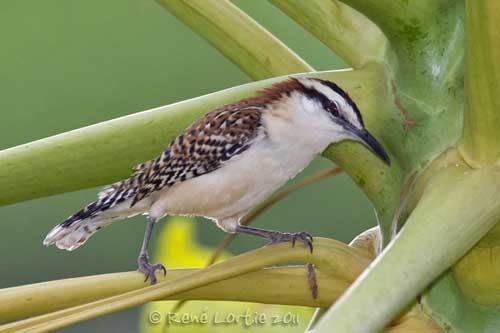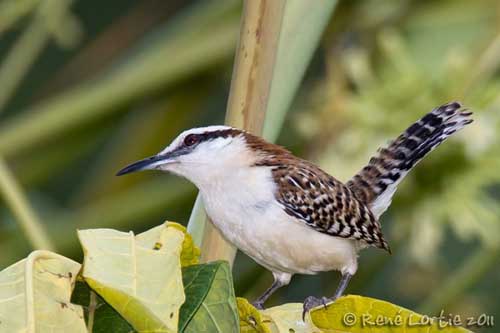
Fr: troglodyte à nuque rousse
All: Rotnacken-Zaunkönig
Esp: Cucarachero Nuquirrufo
Ital: Scricciolo nucarossiccia
Nd: Roodnekwinterkoning
Sd: Rostnackad gärdsmyg
Photographers :
Didier Buysse
Vision d’Oiseaux
Jean Michel Fenerole
Photos d’Oiseaux du monde
Steve Garvie
RAINBIRDER Photo galleries
René Lortie
http://rlortie.ca/
Text by Nicole Bouglouan
Sources :
HANDBOOK OF THE BIRDS OF THE WORLD Vol 10 by Josep del Hoyo-Andrew Elliott-David Christie - Lynx Edicions - ISBN: 8487334725
A GUIDE TO THE BIRDS OF MEXICO AND NORTHERN CENTRAL AMERICA by Steve N. G. Howell, Sophie Webb - Oxford University Press - ISBN: 0198540124
WRENS, DIPPERS AND THRASHERS by Brewer David – illustrated by Barry Kent Mackay- Yale University Press - ISBN: 0300090595
BirdLife International (BirdLife International)
Wikipedia, the free encyclopaedia
Rufous-naped Wren
Campilorhynchus rufinucha
Passeriforme Order – Trogloditidae Family
BIOMETRICS:
Length: 15-19 cm
Weight: 29-32 g
DESCRIPTION:
The Rufous-naped Wren is a large wren found from S Mexico to Costa Rica.
The adult has chestnut-brown nape, back and rump. The shoulders are streaked black and white. On the wings, the primary and secondary flight feathers and their coverts are conspicuously barred blackish and brown. The tail is dark grey-brown with indistinct darker barring. The three outermost rectrices are white-tipped.
On the underparts, chin and throat are white. The breast is creamy-white with small blackish-brown dots in nominate race, whereas the other subspecies have whitish chest. The belly is buff-white with diffuse blackish bars on flanks.
On the head, the crown is blackish. We can see a prominent white supercilium. Lores and eyestripe are blackish. There is a weak black malar stripe.
The bill is blackish. The eyes are reddish-brown. Legs and feet are bluish-grey.

Both sexes are similar.
The juvenile resembles adults but it has buffy-white supercilium and more diffuse back pattern.
We can find six subspecies:
C.r. rufinucha (here described) from E Mexico.
C.r. humilis from W Mexico. It has no streaks on shoulders, rufous-brown crown and indistinct or no spots on the underparts.
C.r. nigricaudatus from S Mexico and W Guatemala. This one has blackish rectrices and unspotted underparts.
C.r. castaneus from interior of Guatemala, E to Honduras and Nicaragua. It is similar to Capistratus with less black markings.
C.r. capistratus from Pacific coasts of El Salvador and Nicaragua, S to NW Costa Rica. It has paler back than Nigricaudatus, and pale brownish-grey bars on central tail feathers.
C.r. nicoyae from Nicoya Peninsula in NW Costa Rica. This one is smaller with strong brown wash on anterior supercilium and breast sides.
The race C.r. capistratus is here displayed through pictures taken in different locations in Costa Rica.
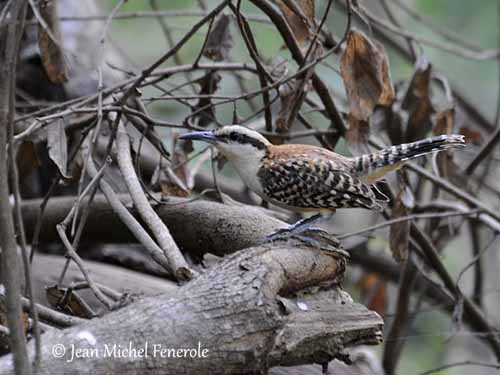
VOICE: SOUNDS BY XENO-CANTO
The Rufous-naped Wren is a noisy bird. The song varies geographically, but all races give rich, melodious phrases often repeated 3-5 times in duet or chorus during which both sexes are equally accomplished.
The song is a series of chortling phrases of 3-8 notes, interspersed with chatters and harsher sounds. This song is often given from elevated perch.
The contact calls “kr-r-r, kr-r-r” are short and harsh.
HABITAT:
The Rufous-naped Wren frequents arid and semi-arid areas, usually with dry scrub. It can be seen in areas modified by human developments. This species is less common in mangroves and lower levels in the cloud forest. It can be seen from sea-level to 800/1200/1400 metres of elevation according to the range.
RANGE:
See above in “subspecies”.
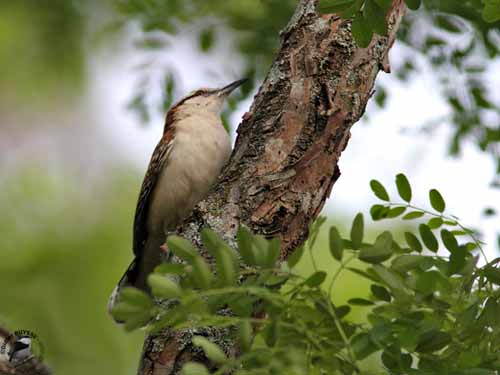
BEHAVIOUR:
The Rufous-naped Wren feeds mainly on small invertebrates such as insects, larvae and spiders. It also takes plant matter, seeds and berries.
It forages on the ground and usually in low vegetation. It is often seen in pairs or small groups of 5-6 birds, giving constant short contact calls. They sometimes search for food near human habitations, and even inside buildings.
In a pair, the mates greet each other by singing in duet while quivering the wings and fanning the tail. Some chases along the branches are observed, accompanied by calls.
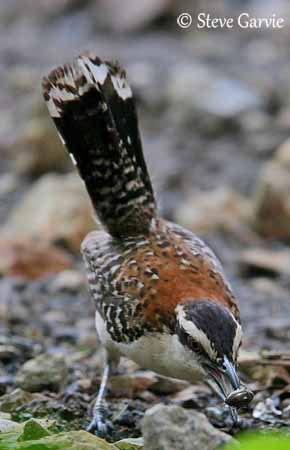
The Rufous-naped Wren is territorial and defends strongly its area, and especially the nesting tree. It attacks the eggs of the other species using the same tree.
The nest is often built in close proximity to wasps’ nests or in acacia where aggressive stinging ants inhabit. These insects provide a good protection against predators such as monkeys, and the protected nests are usually more successful than others.
This species builds nests all year round for roosting purposes.
It does not migrate and seems to be sedentary throughout its range.
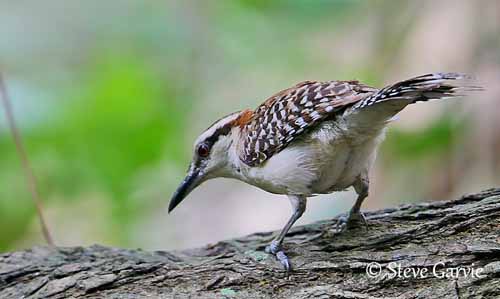
FLIGHT:
The Rufous-naped Wren performs direct and low flight.
REPRODUCTION:
The breeding season occurs between March and July, mainly in April-June.
The nest is built by both sexes, usually in cactus or thorny bush, between 1, 50 and 10 metres above the ground. This is a bulky globular structure made with grass and plant fibres. There is an upward-directed tunnel entrance on the side, which leads into the central nest-chamber lined with soft materials such as down and feathers.
It also may use abandoned hanging nests of other species, and especially of Icterus pectoralis.
The female lays 4-5 white or creamy-white eggs with dark markings. The female incubates alone but the duration is unknown. Both parents feed the young, and occasionally there are some helpers.
They remain in family groups until almost the following breeding season.
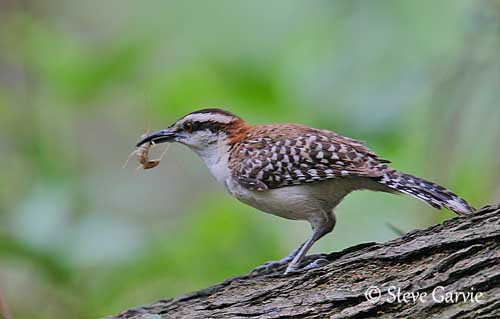
DIET:
The Rufous-naped Wren feeds primarily on insects, larvae and spiders. It probably takes some plant matter, seeds and berries.
It usually forages on the ground.
PROTECTION / THREATS / STATUS:
The Rufous-naped Wren is common and abundant throughout its range.
This species is not currently threatened.
